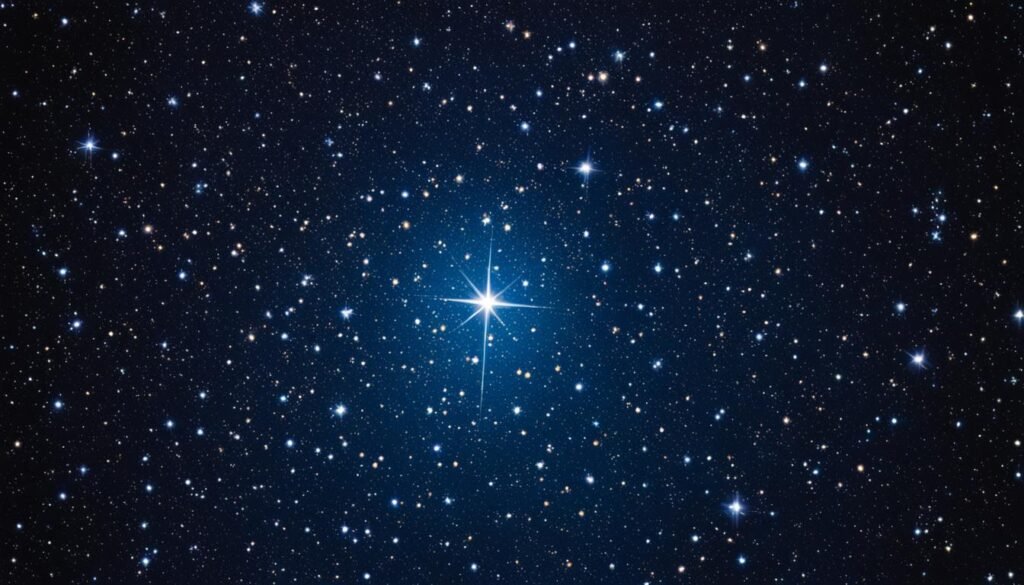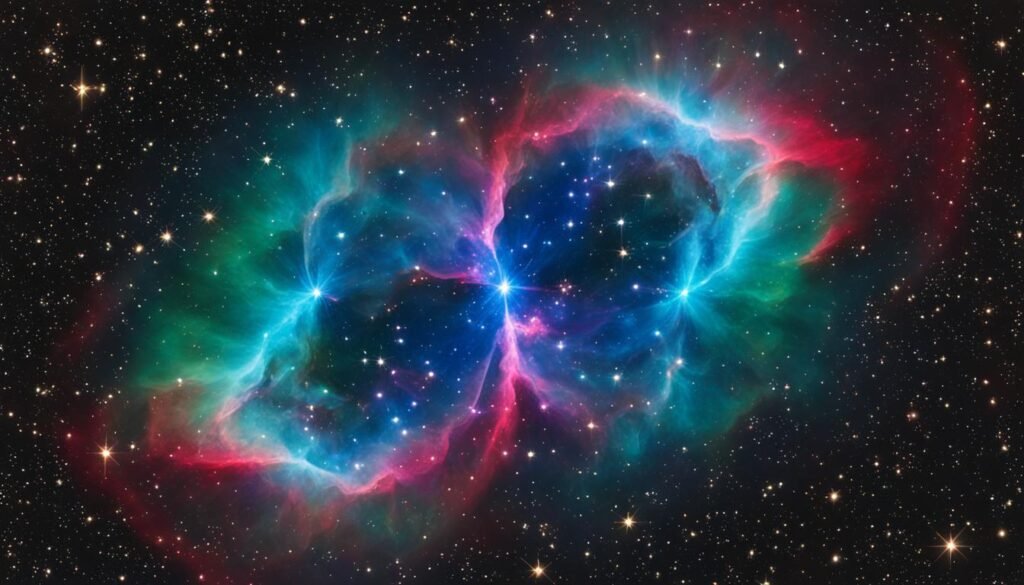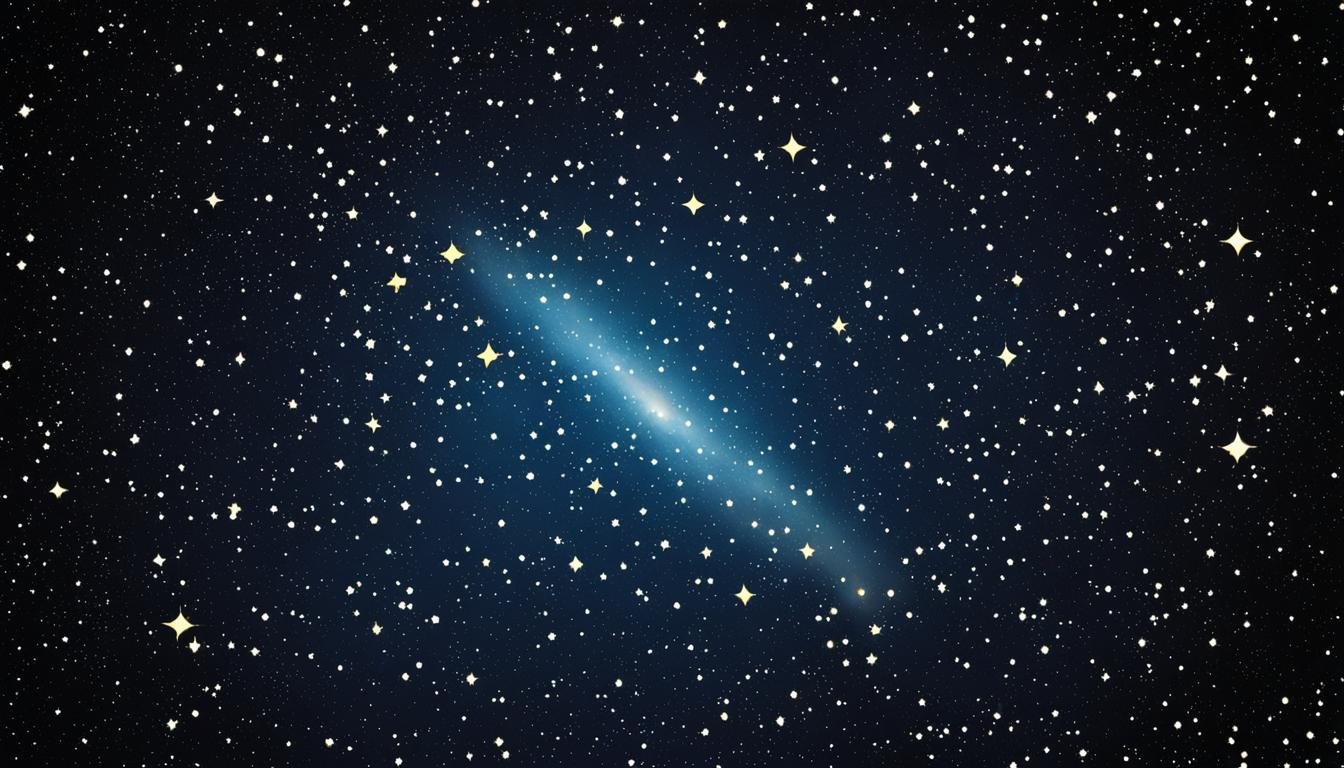| Genitive | |
| Abbreviation | |
| Pronunciation | |
| Main Stars | |
| Brightest Star | |
| Right Ascension | |
| Declination | |
| Sq. Deg. Area | |
| Crosses Meridian | |
| Visible Lat. Range |
Embark on an exploratory quest through the celestial tapestry, where the Constellation Vulpecula, a myriad of twinkling enigmas, awaits your gaze. As you traverse the northern sky, you’ll find yourself captivated by Vulpecula’s elusive charm. Known as “the little fox” in Latin, this astronomical constellation may not be the brightest star at the cosmic ball, but it dazzles in ways that beguile the curious stargazer. This Vulpecula constellation guide is your compass to navigating these celestial wonders, opening up a universe brimming with interstellar treasures.
Imagine the awe as you trace the outlines of the first planetary nebula ever discovered, the Dumbbell Nebula, or when you ponder the significance of encountering the first observed pulsar, PSR B1919+21. Although Vulpecula sits quietly nestled among the Northern Hemisphere’s stars, its history and contributions are far from faint. So ready your telescopes, as this guide unveils a world beyond the fourth magnitude stars, deep within the heart of the little fox in the sky.
Key Takeaways
- Discover the intricate details and rich history behind the elusive Constellation Vulpecula.
- Unveil why Vulpecula, though faint, is a significant celestial wonder in the astronomical community.
- Find out the optimal times and techniques for spotting the Vulpecula constellation in the night sky.
- Learn about the astronomical contributions of Vulpecula, such as the Dumbbell Nebula and the first observed pulsar.
- Understand the location and how to view celestial bodies within the Constellation Vulpecula.
- Gain insights into the dedicated community of astronomers mapping the sky and enhancing our understanding of constellations like Vulpecula.
Exploring the History of Constellation Vulpecula
When you gaze at the night sky, the patterns you see are the legacy of astronomical pioneers, among whom the Polish astronomer Johannes Hevelius stands out. His creation, the Constellation Vulpecula, is an assemblage of stars resembling a little fox, first introduced in 1687. It is fascinating to learn that Hevelius originally connected this constellation with a goose, envisioning it as “Vulpecula cum Ansere.” Though the goose is no longer part of the name, the essence of Hevelius’ vision persists within the Vulpecula constellations list.
You may wonder why Hevelius chose a fox. Interestingly, this decision was not anchored in ancient mythology like many other astronomical constellations; instead, it signified a fresh narrative aligning with the spirit of exploration during his time. Over the years, Vulpecula has experienced a form of celestial evolution: initially divided and then reunited, giving rise to a storied history interwoven with changes in its constituents and boundary decisions.
Even though Vulpecula’s star patterns may not boast the brightness of its celestial neighbors, it holds a precious spot in the sky as a testament to Hevelius’ contribution to the heavens above. The brightest twinkling you can spot within its confines, Alpha Vulpeculae, is often still referred to by its nickname “Anser,” in honor of the long-gone goose. Let’s delve deeper into the configuration of stars that make up this historic constellation.
| Star Name | Designation | Visual Magnitude | Distance (light-years) |
|---|---|---|---|
| Alpha Vulpeculae (Anser) | Brightest star in Vulpecula | 4.44 | Approx. 297 |
| 23 Vulpeculae | Notable binary system | 4.52 | Approx. 328 |
| 31 Vulpeculae | Noteworthy variable star | 4.59 | Approx. 216.57 |
Embarking on a journey through the story of Vulpecula, you become part of a continuum stretching from the telescope of a trailblazing Polish astronomer to the curious eyes of contemporary stargazers. As you align your telescope or tilt your head upwards, remember the legacy that connects you back to Johannes Hevelius and his timeless contributions to the atlas of the heavens.
Stars of Vulpecula: A Celestial Tour
Welcome to the enchanting realm of Vulpecula, where a tapestry of celestial objects beckons the curious eyes of astronomers and stargazers alike. Embark on a celestial tour to discover the splendor of stars of Vulpecula, traversing from luminous giants to mesmerizing binary systems and formidable exoplanetary systems. Each star in this constellation narrates a story, painting a vivid scene in the vastness of the universe.
Alpha Vulpeculae – The Radiant Heart of the Fox
Alpha Vulpeculae, known as Anser, glimmers as the heart of the constellation. This celestial luminary, a fiery M0III red giant, dominates the skies with a magnitude of 4.44 and sits approximately 297 light-years from Earth. Through binoculars, Anser waltzes with its optical companion, 8 Vulpeculae, creating a majestic duo sure to captivate the observer.
23 Vulpeculae – Binary Systems and Cosmic Partnerships
Delve deeper into Vulpecula’s vault and encounter 23 Vulpeculae, a defining member of the constellation’s binary systems. Located 328 light-years away, this star of magnitude 4.52 exists in an intricate cosmic dance with its stellar partner, revealing a partnership that stands as a hallmark of celestial phenomena.
Exploring Variable Stars: 31 Vulpeculae and Its Luminary Companions
The intrigues of Vulpecula continue with 31 Vulpeculae, a variable star of type G8III that enlivens the constellation. Residing 216.57 light-years away, its fluctuating brilliance adds an unpredictable element to the celestial spectacle, offering a dynamic experience for those tracking the Vulpecula star patterns.
HD 189733 – Probing the Depths of an Exoplanetary System
Within the confines of Vulpecula lies the notable binary system HD 189733. This celestial duo comprises an orange dwarf orbited by a red companion and highlighted by the discovery of HD 189733 b, a hot Jupiter class exoplanet. A stone’s throw from the Dumbbell Nebula, this system can be observed with simple stargazing tools, further enriching the enigmatic allure of the Vulpecula constellation.

Spotting Vulpecula in the Night Sky: Tips and Techniques
If you’re passionate about night sky observation and eager to improve your skills in astronomical navigation, identifying the Vulpecula constellation can be a delightful challenge. Spotting Vulpecula requires knowledge of its celestial coordinates and surrounding constellations as your celestial guide. Here’s how to find this elusive fox in the nightscape.
For the best experience in spotting Vulpecula, you’ll want to venture out during the months of July through September. This is when Vulpecula lies prominently between some of the brightest beacons of the night sky that form the Summer Triangle: Vega, Altair, and Deneb. With the right conditions and a clear sky, your pursuit can lead to a beautiful revelation of stars.
| Observation Tips | Technical Guidance |
|---|---|
| 1. Choose a dark location away from city lights | Right Ascension: 20 hours |
| 2. Let your eyes adjust to the darkness for 20 minutes | Declination: +25 degrees |
| 3. Identify the Summer Triangle asterism | Best Viewing Latitudes: +90 to +55 degrees |
| 4. Use a star map to pinpoint Vulpecula’s location | Surrounding Constellations: Cygnus, Lyra, Pegasus, Aquila |
| 5. Use binoculars or a telescope for a closer look | Dimension: 268 square degrees of the night sky |
Keep in mind that Vulpecula does not boast bright stars, so understanding its position relative to nearby constellations can significantly aid in your observation. Cygnus to the north and the neighboring constellations of Pegasus and Aquila to the south act as valuable markers, framing Vulpecula against the tapestry of the night. With patience and perseverance, this small constellation will reveal itself, adding another notch to your astronomical navigation prowess.
Deep Sky Wonders Within the Vulpecula Constellation
Among the celestial sea, Vulpecula constellation serves as a beacon for two rare and intriguing celestial sights, captivating the curiosity of both amateur and seasoned astronomers. As you turn your gaze towards the night sky, brace yourself for a journey through cosmic marvels that exemplify the grandeur of our universe.
Beholding the Dumbbell Nebula: A Planetary Marvel
Within the borders of Vulpecula, lies the Dumbbell Nebula, or Messier 27, one of the most prominent planetary nebulae and first of its kind to be documented. Its unique luminosity and shape make it a celebrated deep sky object, accessible to observers with even modest telescopes. Bearing witness to the end stages of a star’s life, the Dumbbell Nebula is a true cosmic spectacle to behold.

Brocchi’s Cluster – Decoding the Coathanger Asterism
Another gem in Vulpecula’s treasure trove is Brocchi’s Cluster, commonly known to the stargazing community as the Coathanger asterism. This alignment of stars, while not a true cluster, creates a celestial pattern reminiscent of a coathanger. It’s a captivating sight that can best be appreciated through the lens of binoculars, adding diversity to the Vulpecula constellations list.
The Mysteries of NGC 7052: An Elliptical Enigma
Furthest from us, within the boundaries of Vulpecula constellation, looms NGC 7052—one of the more enigmatic elliptical galaxies. This celestial curiosity is distinguished by its colossal black hole and a vast disk of dust revealing the violent history of galaxies in collision. A deep sky challenge to observe, NGC 7052 fascinates astronomers as it continuously unravels the mysteries of our universe.
| Object | Type | Distance | Apparent Magnitude | Notable Features |
|---|---|---|---|---|
| Dumbbell Nebula (Messier 27) | Planetary Nebula | 1,360 light-years | 7.5 | First planetary nebula discovered |
| Brocchi’s Cluster (Coathanger) | Asterism | NA | 3.6 (brightest star) | Resembles a coathanger; not a true cluster |
| NGC 7052 | Elliptical Galaxy | 191 million light-years | 13.4 | Hosts a massive black hole |
In your celestial quest, these star clusters, planetary nebulae, and elliptical galaxies within the Vulpecula constellation are but a few highlights amid a sky brimming with celestial patterns and deep sky objects. As you embrace the night, let these wonders impress upon you the vastness and beauty of our cosmos.
Vulpecula’s Role in Modern Astronomy: Pulsars and Nebulae
In the realm of modern astronomy, the Vulpecula constellation has sown seeds of wonder and scientific discovery. Beginning with the seminal identification of PSR B1919+21, Vulpecula holds the distinction of revealing one of the universe’s most precise timekeepers, the pulsar. These celestial beacons, renowned for their rhythmic pulsations, echo through the cosmos from a staggering 2,283 light-years away. The discovery of this pulsar not only heralded a new chapter in the narrative of neutron stars but also manifested Vulpecula’s celestial importance with unquestionable clarity.
Yet, Vulpecula does not rest its laurels solely on the pulsars like PSR B1919+21. It pushes the envelope with PSR B1937+21, another exotic specimen, furiously rotating at a mind-bending 642 revolutions per second. This rapid rhythm offers a cosmic symphony that anyone with a keen interest in the mechanics of the universe would appreciate. Together, these pulsars form just a fraction of what makes Vulpecula a venerated chapter in the encyclopedia of the skies.
Complementing its array of pulsars, Vulpecula cradles within its borders the majestic Dumbbell Nebula. Magnificently illuminated against the cosmic canvas, this nebula stands as a testament to the life cycles of stars, a fundamental process observed and endeared in astronomical studies. Each pulse and interstellar cloud in Vulpecula enriches the tapestry of modern astronomy, beckoning star gazers and scientists alike to delve deeper into the ever-expanding universe. Your continued exploration of the night sky is a journey through time and space, guided by the little fox’s immutable lights.
FAQ
What is the Constellation Vulpecula?
The Constellation Vulpecula, Latin for “the little fox,” is an astronomical constellation situated in the northern sky, known for its faint stars and notable deep sky objects, including the first discovered planetary nebula and pulsar.
Who discovered the Constellation Vulpecula, and when?
Polish astronomer Johannes Hevelius introduced the Constellation Vulpecula in 1687, initially depicting it as “Vulpecula cum ansere,” which means the fox with the goose.
What are the main stars of Vulpecula?
The main stars of Vulpecula include Alpha Vulpeculae, also known as Anser, 23 Vulpeculae—a binary star system, and the variable star 31 Vulpeculae, among others. These celestial objects contribute to the Vulpecula constellation’s allure.
Can you tell us about Alpha Vulpeculae?
Alpha Vulpeculae, christened Anser, is an M0III red giant and the brightest star in the Vulpecula constellation, with a magnitude of 4.44, positioned approximately 297 light-years from Earth.
How can I locate Vulpecula in the night sky?
Spotting Vulpecula is best between July and September in the Northern Hemisphere, nestled within the Summer Triangle formed by Vega, Altair, and Deneb. Using the right ascension of 20 hours and a declination of +25 degrees helps to navigate its stars.
What deep sky wonders are found in Vulpecula?
The Vulpecula constellation houses deep sky wonders such as the Dumbbell Nebula (Messier 27), the Coathanger asterism (Brocchi’s Cluster), and NGC 7052—an elliptical galaxy with an active galactic nucleus.
Why is Vulpecula significant in modern astronomy?
Vulpecula’s significance in modern astronomy lies in its contribution to the study of pulsars and nebulae, exemplified by PSR B1919+21, the first pulsar discovered, and the Dumbbell Nebula, the first planetary nebula observed.
What is an asterism, and which one is associated with Vulpecula?
An asterism is a recognizable pattern of stars that is not one of the officially recognized constellations. Associated with Vulpecula is Brocchi’s Cluster, commonly known as the Coathanger, which is a prominent visual feature in the constellation.
Are there any exoplanets or binary systems in Vulpecula?
Yes, Vulpecula contains binary star systems like 23 Vulpeculae and HD 189733, an exoplanetary system housing HD 189733 b, a hot Jupiter class exoplanet.
What kind of telescopic equipment is required to observe Vulpecula’s celestial objects?
Many of Vulpecula’s celestial wonders, such as the Dumbbell Nebula and the Coathanger asterism, can be observed with amateur telescopes or even binoculars, making them accessible to novice astronomers.






